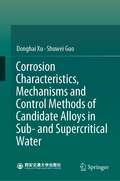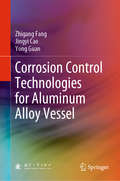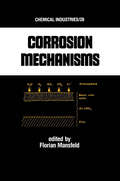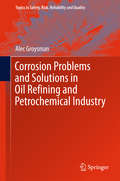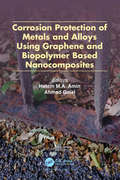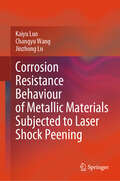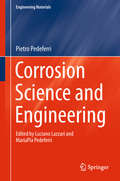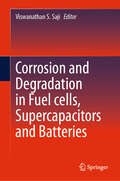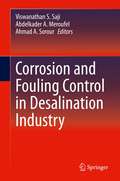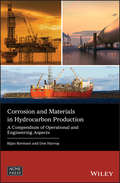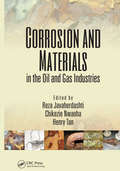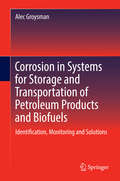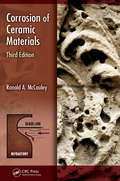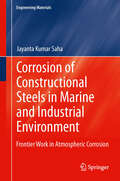- Table View
- List View
Corrosion Analysis
by Michael DornbuschThe book gives an overview about all relevant electrochemical and spectroscopic methods used in corrosion research. Besides the correct use and interpretation, the methods are correlated with industrial test methods for organic coatings and conversion layers.
Corrosion Characteristics, Mechanisms and Control Methods of Candidate Alloys in Sub- and Supercritical Water
by Donghai Xu Shuwei GuoThis book aims to provide comprehensive and systematic introduction and summary of corrosion characteristics, mechanisms, and control methods of candidate alloys in sub- and supercritical water environment. First of all, corrosion types of candidate alloys and the effects of major alloying elements on corrosion resistance of potential alloys in sub- and supercritical water are compared and analyzed. At the same time, research status of candidate materials, and development and application trends of several corrosion-resistant alloys are summarized. Then, corrosion characteristics of Ni-Cr, Ni-Cr-Mo, Ni-Fe-Cr and Ni-Fe-Cr-Mo-Cu corrosion-resistant alloys, FeCrAl alloy, and Zircaloy are discussed in detail, including the corrosion rate, the structure and composition of oxide film, and the effects of various surface treatment processes, etc. More specifically, it also investigates corrosion behavior of Ni-based alloy, Fe-Ni-based, and stainless steels in supercritical water. The effects of aggressive species on the corrosion behavior of Ni-base alloys are also explored in supercritical water. Readers will further discover the total corrosion processes and mechanisms of typical candidate alloys in sub- and supercritical water environment. Finally, the work explores the corrosion control methods such as ceramic coatings and passivation processes in supercritical water oxidation and in subcritical water, respectively. Future challenges and development trends of corrosion research of candidate materials in sub- and supercritical water environments are covered at the end of this book. It offers valuable reference for theoretically guiding material selection and design and operating parameter optimization of key equipment in the sub- and supercritical water technologies. The book is written for senior undergraduates, graduate students, scholars, and researchers who are interested in corrosion behavior of candidate materials of supercritical water oxidation system, supercritical water gasification system, and nuclear reactor.
Corrosion Chemistry
by Volkan Cicek Bayan Al-NumanCorrosion Chemistry details the scientific background of the corrosion process and contemporary applications for dealing with corrosion for engineers and scientists, covering the most recent breakthroughs and trends. Corrosion is in essence a chemical process, and it is crucial to understand the dynamics from a chemical perspective before proceeding with analyses, designs and solutions from an engineering aspect. This book can be used both as a textbook and a reference book both by academics and engineers and scientists in the field. As a reference for the engineer in the field, it is both a refresher for the veteran on the causes of corrosion and the methods, processes, and technologies to deal with it, over a variety of industries. It is the most up-to-date, comprehensive treatment of corrosion available, covering the most cutting-edge new processes and theories. For the freshman engineer just entering the field, it is a tremendous introduction to corrosion. As a textbook, it can be used for a single semester technical elective course in undergraduate and postgraduate education for disciplines such as chemistry, chemical engineering, petroleum engineering, civil engineering, material engineering, mechanical engineering, metallurgical engineering, mining engineering, agricultural engineering, and other related technical fields.
Corrosion Control Technologies for Aluminum Alloy Vessel
by Yong Guan Zhigang Fang Jingyi CaoThis book elaborates the corrosion testing and assessment methods for the aluminum alloy vessel in the service and internal environment. The emphasis is placed on the research of general materials corrosion characteristics, electrochemical protection design, surface protection, coating and painting, etc. This book helps readers to keep abreast of the whole technology system of the corrosion prevention and control of aluminum alloy vessel, especially the systematic engineering view of life cycle corrosion control for the vessel is of particular interest to readers.
Corrosion Control Through Organic Coatings (Corrosion Technology)
by Amy Forsgren Ole Øystein KnudsenCorrosion Control Through Organic Coatings, Second Edition provides readers with useful knowledge of the practical aspects of corrosion protection with organic coatings and links this to ongoing research and development. Thoroughly updated and reorganized to reflect the latest advances, this new edition expands its coverage with new chapters on coating degradation, protective properties, coatings for submerged service, powder coatings, and chemical pretreatment. Maintaining its authoritative treatment of the subject, the book reviews such topics as corrosion-protective pigments, waterborne coatings, weathering, aging, and degradation of paint, and environmental impact of commonly used techniques including dry- and wet-abrasive blasting and hydrojetting. It also discusses theory and practice of accelerated testing of coatings to assist readers in developing more accurate tests and determine corrosion protection performance.
Corrosion Control and Surface Finishing: Environmentally Friendly Approaches
by Hideyuki Kanematsu Dana M. BarryThis book deals with the surface finishing for corrosion prevention fromthe viewpoint of environmental friendliness. Surface finishing for metallic materialsor by metallic materials has excellent corrosion resistance, wear resistance andgood color tones, which have been useful for practical applications so far. However,environmental friendliness and user friendliness have become important factors forpractical use since the turn of the century. Surface Finishing Industries are nowfacing a serious crossroad to continue sustainable developments in the future. Sadly,the concept of environmental friendliness is very new, because from the beginningof this discipline (surface finishing), not many people considered the environmentaleffects so seriously, but sought mainly for the functions, performance, characteristics,and economic profits. Since the biological evaluation processes are very advancedand still debated, this book is very unique and advanced. This book aims to letuniversity students know and learn the concept of environmental friendliness andits relation to surface treatment products based on the fundamental knowledge aboutconventional corrosion control and surface finishing. The textbook will be usedmost effectively with subjects such as surface science, surface engineering, mechanicalmaterials, etc. for those studying mechanical engineering, materials engineeringand chemical engineering. It is also applicable to practical engineers and researchersin the industrial world as well as the academic one. Throughout this book, readerslearn and appreciate the environmentally friendly approaches that are presentedfor corrosion control and surface finishing.
Corrosion Failures
by K. Elayaperumal V. S. RajaProvides corrosion basics in a lucid manner to students and working professionals and over 80 corrosion-failure analysis case studies Correlates Failure Analysis with Corrosion Science Exclusively provides corrosion-related failure analysis case histories in one place in a convenient format One-stop shop for both science and real time occurrence of the phenomenon of corrosion Full coverage of all MOC, Materials of Construction, used for process equipments Simple but Lucid presentation of Failure Analysis procedure
Corrosion Mechanisms (Chemical Industries Ser. #28)
by Florian B. MansfeldThis book discusses the mechanisms that have been proposed for the main corrosion phenomena, providing a thorough discussion of the pros and cons of the various corrosion mechanisms with support by experimental and theoretical results.
Corrosion Preventive Materials and Corrosion Testing
by S.K. Dhawan Hema Bhandari Gazala Ruhi Brij Mohan Bisht Pradeep SambyalThe book provides an extensive coverage of conjugated polymer based nano-composite coatings with advanced anti-corrosive properties. The book gives detailed explanation of corrosion testing methods and techniques to evaluate the corrosion resistance of the coatings. It includes elaborate discussion on classification of corrosion, electrochemistry of corrosion process, theories explaining the mechanism of corrosion and various corrosion testing standards. Electrochemical studies like open circuit potential (OCP) variation with time, potentiodynamic polarization, Electrochemical Impedance Spectroscopy (EIS) and accelerated corrosion testing are highlighted as important tools to extract information about the behavior of coatings under corrosive conditions. The book discusses epoxy-conjugated polymer based novel composite coating formulations, including aniline and o-toluidine, o-anisidine, phenetidine and pentafluoroaniline with appropriate fillers like SiO2, flyash, ZrO2 nanoparticles, and chitosan for the protection of metallic substrates. A general discussion on the self healing mechanism of epoxy-polypyrrole based biopolymer hybrid composite coatings is included in this book. This book provides a critical review on the conjugated polymer based composite coatings with superior corrosion resistance, good mechanical integrity, better adhesion properties and self healing ability under highly aggressive conditions which can be commercially used for the protection of metal substrates from corrosion.
Corrosion Problems and Solutions in Oil Refining and Petrochemical Industry (Topics in Safety, Risk, Reliability and Quality #32)
by Alec GroysmanThis book addresses corrosion problems and their solutions at facilities in the oil refining and petrochemical industry, including cooling water and boiler feed water units. Further, it describes and analyzes corrosion control actions, corrosion monitoring, and corrosion management. Corrosion problems are a perennial issue in the oil refining and petrochemical industry, as they lead to a deterioration of the functional properties of metallic equipment and harm the environment - both of which need to be protected for the sake of current and future generations. Accordingly, this book examines and analyzes typical and atypical corrosion failure cases and their prevention at refineries and petrochemical facilities, including problems with: pipelines, tanks, furnaces, distillation columns, absorbers, heat exchangers, and pumps. In addition, it describes naphthenic acid corrosion, stress corrosion cracking, hydrogen damages, sulfidic corrosion, microbiologically induced corrosion, erosion-corrosion, and corrosion fatigue occurring at refinery units. At last, fouling, corrosion and cleaning are discussed in this book.
Corrosion Protection for the Oil and Gas Industry: Pipelines, Subsea Equipment, and Structures
by Mavis OkyereCorrosion Protection for the Oil and Gas Industry: Pipelines, Subsea Equipment, and Structures summarizes the main causes of corrosion and requirements for materials protection, selection of corrosion-resistant materials and coating materials commonly used for corrosion protection, and the limitations to their use, application, and repair. <p><p>This book focuses on the protection of steels against corrosion in an aqueous environment, either immersed in seawater or buried. It also includes guidelines for the design of cathodic protection systems and reviews of cathodic protection methods, materials, installation, and monitoring. It is concerned primarily with the external and internal corrosion protection of onshore pipelines and subsea pipelines, but reference is also made to the protection of other equipment, subsea structures, risers, and shore approaches. Two case studies, design examples, and the author’s own experiences as a pipeline integrity engineer are featured in this book. Readers will develop a high quality and in-depth understanding of the corrosion protection methods available and apply them to solve corrosion engineering problems. <p><p>This book is aimed at students, practicing engineers, and scientists as an introduction to corrosion protection for the oil and gas industry, as well as to overcoming corrosion issues.
Corrosion Protection of Metals and Alloys Using Graphene and Biopolymer Based Nanocomposites
by Hatem M.A. Amin and Ahmed GalalWith contributions from experts from both academia and industry, this book provides up-to-date reviews and promising approaches for corrosion control of metals and alloys via sustainable biopolymers and carbon nanomaterials coatings, focusing on the wonder material “graphene” which is more solid than steel. This book delivers essential information for improving the environmental and economic viability of current coating technologies. It is also a valuable reference for those who are interested in corrosion science and corrosion protection including professionals from the industry as well as academia.
Corrosion Protection of Metals by Intrinsically Conducting Polymers
by Pravin P. Deshpande Dimitra SazouThe use of conducting polymers for the anticorrosion protection of metals has attracted great interest during the last 30 years. The design and development of conducting polymers-based coating systems with commercial viability is expected to be advanced by applying nanotechnology and has received substantial attention recently. This book begins wit
Corrosion Resistance Behaviour of Metallic Materials Subjected to Laser Shock Peening
by Jinzhong Lu Kaiyu Luo Changyu WangThis book introduces the fundamentals of laser shock peening (LSP) and its effects on the corrosion behaviours of metal alloy materials. It focuses on innovations in theory and methods related to LSP-induced surface nanocrystallization and corrosion resistance in steels, Mg alloy and titanium alloy. The main contents of the book include the characteristics of laser shock wave, LSP-induced surface integrity and the anti-corrosion mechanism. The research has accumulated a large amount of experimental data, which has proven the significant effectiveness of LSP in improving the corrosion performance of metal alloy materials. The related findings provide theoretical guidance and a data foundation for the application of LSP in fields such as aerospace and nuclear industry. This book could be useful for researchers working in the fields of LSP, corrosion behaviour, machine manufacturing and surface engineering, as well as those majoring in laser shock wave and materials science. The analysis in the book will help readers deeply understand the anti-corrosion mechanism induced by LSP and may inspire them to further develop this technology.
Corrosion Resistance of Steels, Nickel Alloys, and Zinc in Aqueous Media: Waste Water, Seawater, Drinking Water, High-Purity Water
by Michael Schütze Marcel Roche Roman BenderThis handbook is derived from the online reference "Corrosion Handbook", bringing together the relevant information about corrosion protection and prevention for steels, one of the most widely used materials. It provides comprehensive information, including tabulated data and references, on the corrosion properties of the following materials: Unalloyed steels and cast steel, unalloyed cast iron, high-alloy cast iron, high-silicon cast iron, structural steels with up to 12% chromium, ferritic chromium steels with more than 12% chromium, ferritic-austenitic steels with more than 12% chromium, high-alloy multiphase steels, ferritic/perlitic-martensitic steels, ferritic-austenitic steels/duplex steels, austenitic chromium-nickel steels, austenitic chromium-nickel-molybdenum steels, austenitic chromium-nickel steels with special alloying additions, special iron-based alloys, and zinc. The following corrosive media are considered: Seawater, brackish water, industrial waste water, municipal waste water, drinking water, high-purity water.
Corrosion Science and Engineering (Engineering Materials)
by Pietro PedeferriThis textbook discusses the latest advances in the corrosion of metals and related protection methods, and explores all corrosion-related aspects used in natural and industrial environments, including monitoring and testing. Throughout the textbook, the science and engineering of corrosion are merged to help readers perform correct corrosion assessments in both the design phase and plant management phase, and to define the optimal protection technique. In addition, the book addresses basic aspects of corrosion science, including the electrochemical mechanism, thermodynamic and kinetic aspects, the use of Pourbaix and Evans diagrams, and various forms of corrosion (from uniform to localised to stress corrosion phenomena); as well as the protection systems adopted to combat corrosion, including inhibitors, coatings and cathodic protection. Such basic knowledge is fundamental to understanding the “corrosion engineering” approach applied to the durability of metals immersed in water, buried in soil, exposed to the atmosphere, used in reinforced concrete, in the human body and in petrochemical plants, or at risk of high-temperature corrosion. A final chapter is dedicated to the use of statistics in corrosion. All chapters include exercises and practical examples to help students understand, predict, evaluate and mitigate corrosion problems. As such, the book offers the ideal learning resource for all students of corrosion courses in chemical, mechanical, energy and materials engineering at the graduate and advanced undergraduate level, as well as a valuable reference guide for engineers whose work involves real-world applications.
Corrosion and Degradation in Fuel Cells, Supercapacitors and Batteries
by Viswanathan S. SajiThis book discusses research and development on various degradation types and their mitigation approaches in electrochemical energy storage and conversion (EESC) devices, such as fuel cells, batteries, and supercapacitors, essential to realizing carbon neutrality and a sustainable energy economy. Corrosion and degradation of the components remains a major threat to EESC devices' long-term durability, and at present there is an insufficient number of book-length treatments of this topic. This volume brings together the most up-to-date findings from the research literature.
Corrosion and Fouling Control in Desalination Industry
by Viswanathan S. Saji Abdelkader A. Meroufel Ahmad A. SorourThis book addresses two critical problems that plague materials that make up components in both desalination and cooling water systems: corrosion, and fouling. The book addresses various types and components of industrial desalination technologies with solutions for controlling corrosion, scaling and biofouling. Issues unique to desalination systems, vital for the production of clean water, are considered as well. Green technologies are discussed throughout, along with environmental and economic considerations. The book presents solutions to the problems encountered by internal and external parts of these systems and will aid professionals that design, operate, and maintain them. It will be valuable to professionals in the materials, corrosion, electrochemical and wastewater industries, as well as chemical engineers.Addresses the corrosion issues facing the conventional and modern water desalination systems;Discusses the causes and remediation of problems caused by corrosion, scaling, and biofouling in water treatment;Offers green solutions, thereby minimizing environmental impact while increasing control and productivity of water systems;Suitable for professionals working with water desalination plants, materials scientists and corrosion engineers.
Corrosion and Materials in Hydrocarbon Production: A Compendium of Operational and Engineering Aspects (Wiley-ASME Press Series)
by Dr. Bijan Kermani Don HarropComprehensively covers the engineering aspects of corrosion and materials in hydrocarbon production This book captures the current understanding of corrosion processes in upstream operations and provides a brief overview of parameters and measures needed for optimum design of facilities. It focuses on internal corrosion occurring in hydrocarbon production environments and the key issues affecting its occurrence, including: the types and morphology of corrosion damage; principal metallic materials deployed; and mitigating measures to optimise its occurrence. The book also highlights important areas of progress and challenges, and looks toward the future of research and development to enable improved and economical design of facilities for oil and a gas production. Written for both those familiar and unfamiliar with the subject—and by two authors with more than 60 years combined industry experience—this book covers everything from Corrosion Resistant Alloys (CRAs) to internal metal loss corrosion threats, corrosion in injection systems to microbiologically influenced corrosion, corrosion risk analysis to corrosion and integrity management, and more, notably: Comprehensively covers the engineering aspects of corrosion and materials in hydrocarbon production Written by two, renowned experts in the field Offers practical guide to those unfamiliar with the subject whilst providing a focused roadmap to addressing the topics in a precise and methodical manner Covers all aspects of corrosion threat and remedial and mitigation measures in upstream hydrocarbon production applicable to sub-surface, surface, and transportation facilities Outlines technology challenges that need further research as a pre-cursor to moving the industry forward. Operational and Engineering Aspects of Corrosion and Materials in Hydrocarbon Production is an excellent guide for both practicing materials and corrosion engineers working in hydrocarbons production as well as those entering the area who may not be fully familiar with the subject.
Corrosion and Materials in the Oil and Gas Industries
by Chikezie Nwaoha Reza Javaherdashti Henry TanThe advancement of methods and technologies in the oil and gas industries calls for new insight into the corrosion problems these industries face daily. With the application of more precise instruments and laboratory techniques as well as the development of new scientific paradigms, corrosion professionals are also witnessing a new era in the way d
Corrosion and Reliability Assessment of Inspected Pipelines
by Franck Schoefs Mauricio Sánchez-Silva Felipe Muñoz Rafael Amaya-Gómez Emilio Bastidas-ArteagaThis book provides the most up-to-date, advanced methods and tools for risk assessment of onshore pipelines. These methods and tools are based primarily on information collected from ILI measurements and additional information about the soil surrounding the pipeline. The book provides a better understanding how the defects grow and interact (repulsion or attraction) and their spatial variability. In addition, the authors contemplate new defects that evolve between inspections and how they could affect the pipeline's reliability. A real-world case is presented to reinforce the concepts presented in the book. The book is structured into three parts: i) an introduction to onshore pipelines and the problem of corrosion, ii) a framework that deals with uncertainty for integrity programs for corroded pipelines, and iii) the applications of the methods presented in the book. The book is ideal for researchers and field engineers in oil and gas transportation and graduate and undergraduate engineering students interested in pipeline reliability assessments, spatial variability, and risk-based inspections.
Corrosion in CO2 Capture, Transportation, Geological Utilization and Storage: Causes and Mitigation Strategies (Engineering Materials)
by Liwei ZhangThis book systematically discusses the operational stages with high risk of CO2-induced corrosion in CCUS projects, and related measures for corrosion control. CO2 capture, utilization, and storage (CCUS) is a key technology to mitigate climate change and substantially reduce greenhouse gas emissions from fossil fuels. CCUS deals with high concentration CO2, which is very corrosive in a humid environment. Therefore, it is very important to characterize, monitor, and mitigate CO2-induced corrosion in all processes of the CCUS operation chain. Some corrosion control techniques included in this book (e.g., CO2-resisting wellbore cement additives) are beneficial for corrosion control research and engineering practices. This book belongs to the field of corrosion science and engineering, and the expected readership is researchers and engineers working on CCUS.
Corrosion in Systems for Storage and Transportation of Petroleum Products and Biofuels: Identification, Monitoring and Solutions
by Alec GroysmanThis book treats corrosion as it occurs and affects processes in real-world situations, and thus points the way to practical solutions. Topics described include the conditions in which petroleum products are corrosive to metals; corrosion mechanisms of petroleum products; which parts of storage tanks containing crude oils and petroleum products undergo corrosion; dependence of corrosion in tanks on type of petroleum products; aggressiveness of petroleum products to polymeric material; how microorganisms take part in corrosion of tanks and pipes containing petroleum products; which corrosion monitoring methods are used in systems for storage and transportation of petroleum products; what corrosion control measures should be chosen; how to choose coatings for inner and outer surfaces of tanks containing petroleum products; and how different additives (oxygenates, aromatic solvents) to petroleum products and biofuels influence metallic and polymeric materials. The book is of interest to corrosion engineers, materials engineers, oil and gas engineers, petroleum engineers, chemists, chemical engineers, mechanical engineers, failure analysts, scientists, and students, designers of tanks, pipelines and other systems for storage and transportation fuels, technicians. The book is of interest to corrosion engineers, materials engineers, oil and gas engineers, petroleum engineers, chemists, chemical engineers, mechanical engineers, failure analysts, scientists, and students, designers of tanks, pipelines and other systems for storage and transportation fuels, technicians. The book is of interest to corrosion engineers, materials engineers, oil and gas engineers, petroleum engineers, chemists, chemical engineers, mechanical engineers, failure analysts, scientists, and students, designers of tanks, pipelines and other systems for storage and transportation fuels, technicians.
Corrosion of Ceramic Materials (Corrosion Technology)
by Ronald A. McCauleyReflecting the many changes in the field since the publication of the second edition, Corrosion of Ceramic Materials, Third Edition incorporates more information on bioceramics, including nanomaterials, as well as the weathering of construction materials. Adhering to the original plan of classification by chemistry, this edition reorganizes the top
Corrosion of Constructional Steels in Marine and Industrial Environment: Frontier Work in Atmospheric Corrosion (Engineering Materials)
by Jayanta Kumar SahaThe book entails investigative methods for better understanding of the degradation process and uses of high performance paints formulation and also compares them on mild steel (MS) and weathering steel (WS) through various AC/DC electrochemical test methods and surface characterization through electron microscopy, XRD and Raman spectroscopy. This book also deals with the corrosion studies undertaken considering three phases (solid, liquid and gas) with latest techniques and the emphasis has also been given on degradation of materials due to atmospheric corrosion as this is of immense interest to present engineers and researchers. MS has got versatile application as structural steel for construction of buildings, bridges, flyovers, pipelines etc. But this is very much prone to corrosion in industrial and marine environments in presence of harmful pollutants and other industrial effluents in addition to normal humid atmosphere. These corrosion problems are much severe in a tropical country like India with vast coastline. MS corrodes relatively faster and thus leads to colossal loss in every year and to reduce this loss some kind of protection in the form of paints and coatings is always used. Painting is an effective means but quite costly amounting 10-15% of the initial construction cost of superstructures besides cost of repainting at regular interval.

